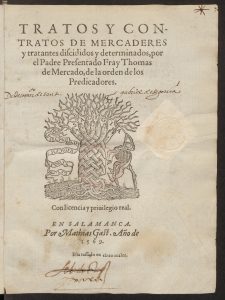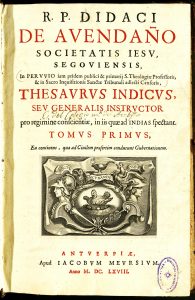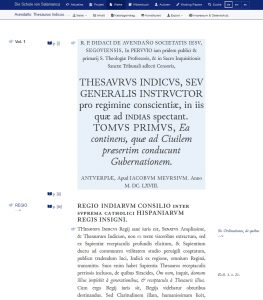Diego de Avendaño (1594-1688) wurde in Segovia geboren. Während seiner Studienzeit in Sevilla lernte er Juan de Solórzano Pereira kennen und begleitete ihn noch vor seinem zwanzigsten Geburtstag in die Neue Welt. Avendaño setzte seine Studien in Lima am Colegio San Martín der Jesuiten fort, trat selbst in den Orden ein und unterrichtete und leitete in den folgenden Jahrzehnten die Kollegien und Ordensuniversitäten in Cuzco, Charcas und Lima. Nach, wie er selbst sagte, „beinahe fünfzig Jahren in Peru“ veröffentlichte er mit dem sechsbändigen Thesaurus Indicus sein Hauptwerk, in dem er eine Fülle von Fragen weltlicher Verwaltung und geistlicher Praxis bespricht. Alle sechs Bände werden sukzessive in der Digitalen Quellensammlung des Projekts „Die Schule von Salamanca“ erscheinen. Ein Anfang ist nun mit dem ersten Band, der sich den Fragen des weltlichen Regiments Perus im 16. und frühen 17. Jahrhundert widmet, gemacht.
Monat: September 2019
(English) José Luis Egío: The Emergence of Scholastic Probabilism in a Global Perspective
In the last session of the Salamanca colloquium, José Luis Egío drew on his in-depth knowledge of the sources acquired by the intense editorial work done in the project and traced some roots of scholastic probabilism in the 16th century.
The history of probabilism has been the subject of important recent publications on scholastic legal and theological thought (Tutino, OUP, 2018; Schüssler, Brill, 2019). Nevertheless, the contribution of the specific historical context and global dimension of the early modern period’s enormous political, religious and economic changes to the emergence of probabilism has usually been underestimated and has received little attention. However, by exploring the missionary and mercantile fields and the writings of members of the School of Salamanca such as Francisco de Vitoria, Tomás de Mercado and Alonso de la Vera Cruz, José Luis Egío showed how the increasing use of probable argumentation was one of the many strategies employed by jurists and theologians to accommodate or translate the normative framework of European theology and canon law to new and unforeseen contexts and to try to answer new dubia.

